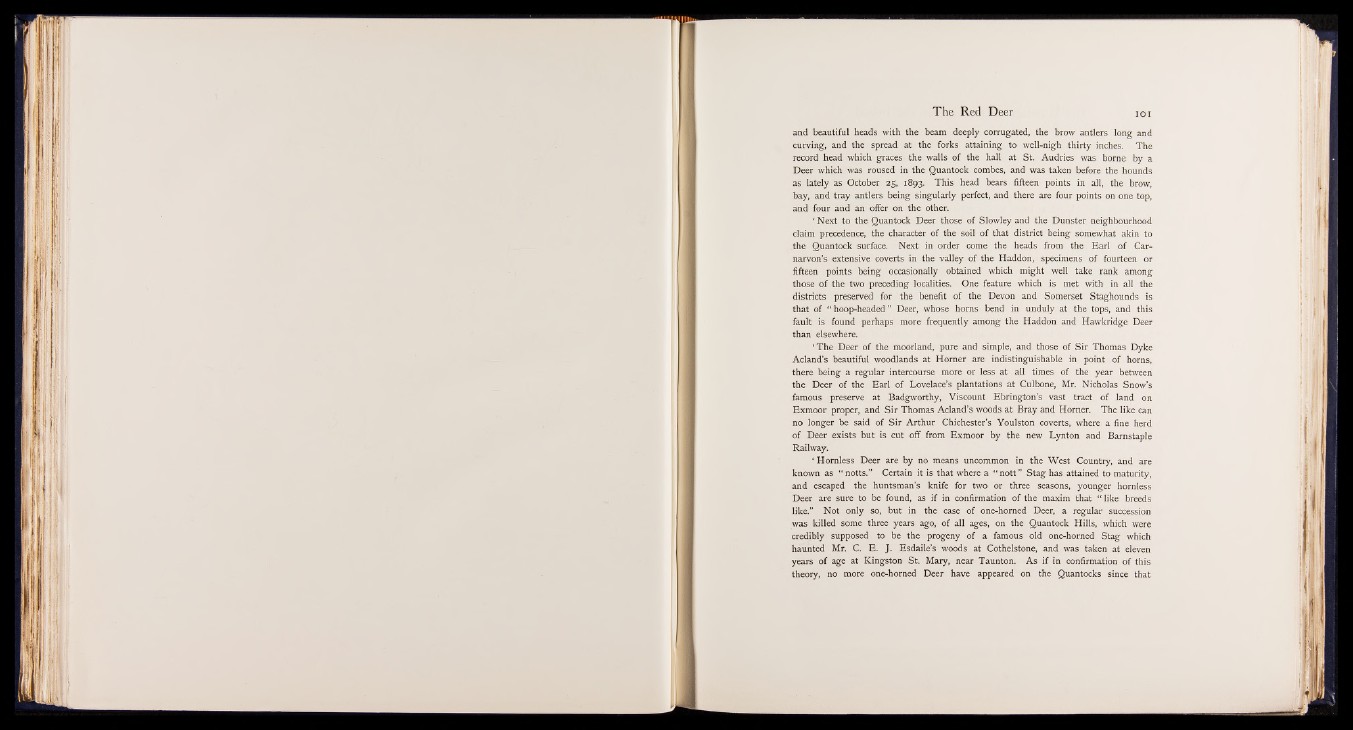
and beautiful heads with the beam deeply corrugated, the brow antlers long and
curving, and the spread at the forks attaining to well-nigh thirty inches. The
record head which graces the walls of the hall at St. Audries was borne by a
Deer which was roused in the Quantock combes, and was taken before the hounds
as lately as October 25, 1893. This head bears fifteen points in all, the brow,
bay, and tray antlers being singularly perfect, and there are four points on one top,
and four and an offer on the other.
‘ Next to the Quantock Deer those of Slowley and the Dunster neighbourhood
claim precedence, the character of the soil of that district being somewhat akin to
the Quantock surface. Next in order come the heads from the Earl of Carnarvon’s
extensive coverts in the valley of the Haddon, specimens of fourteen or
fifteen points being occasionally obtained which might well take rank among
those of the two preceding localities. One feature which is met with in all the
districts preserved for the benefit of the Devon and Somerset Staghounds is
that of “ hoop-headed” Deer, whose horns bend in unduly at the tops, and this
fault is found perhaps more frequently among the Haddon and Hawkridge Deer
than elsewhere.
‘ The Deer of the moorland, pure and simple, and those of Sir Thomas Dyke
Acland’s beautiful woodlands at Horner are indistinguishable in point of horns,
there being a regular intercourse more or less at all times of the year between
the Deer of the Earl of Lovelace’s plantations at Culbone, Mr. Nicholas Snow’s
famous preserve at Badgworthy, Viscount Ebrington’s vast tract of land on
Exmoor proper, and Sir Thomas Acland’s woods at Bray and Horner. The like can
no longer be said of Sir Arthur Chichester’s Youlston coverts, where a fine herd
of Deer exists but is cut off from Exmoor by the new Lynton and Barnstaple
Railway.
‘ Hornless Deer are by no means uncommon in the West Country, and are
known as “ notts.” Certain it is that where a “ nott ” Stag has attained to maturity,
and escaped the huntsman’s knife for two or three seasons, younger hornless
Deer are sure to be found, as if in confirmation of the maxim that “ like breeds
like." Not only so, but in the case of one-horned Deer, a regular succession
was killed some three years ago, of all ages, on the Quantock Hills, which were
credibly supposed to be the progeny of a famous old one-horned Stag which
haunted Mr. C. E. J. Esdaile’s woods at Cothelstone, and was taken at eleven
years of age at Kingston St. Mary, near Taunton. As if in confirmation of this
theory, no more one-horned Deer have appeared on the Quantocks since that